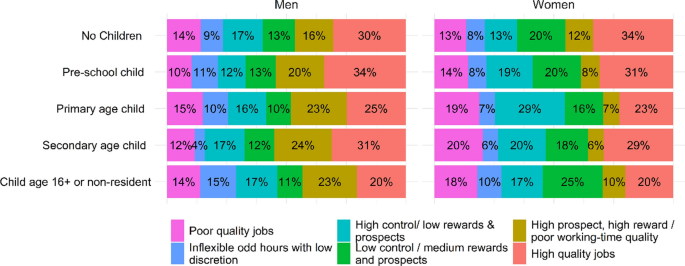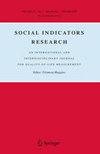Parenthood and Job Quality: Is There a Motherhood Penalty in the UK?
IF 2.8
2区 社会学
Q1 SOCIAL SCIENCES, INTERDISCIPLINARY
引用次数: 0
Abstract
Abstract Current research recognises the role of parenthood in contributing to gender inequalities at work. Meanwhile, there is a growing interest in job quality. We contribute to both these debates by analysing differences in job quality by gender and parenthood status, using data from a nationally representative UK household survey. We develop a 12-indicator, multi-dimensional measure of job quality and use this to analyse the combination and distribution of job quality attributes by gender and parenthood status. Our analysis shows that women and mothers are under-represented in high quality jobs and over-represented in poor quality jobs. While some mothers sacrifice career prospects for flexibility, motherhood is not always associated with more flexibility, and job quality disadvantages are multi-faceted. Working part time is a strong driver of job quality differences, suggesting that reduced hours after motherhood impacts on job quality in addition to worsening women’s pay. Job quality gaps are larger for mothers of school-aged children, pointing to the additional constraints of managing work and childcare around the school day.

为人父母与工作质量:英国是否存在为人母的惩罚?
目前的研究认识到父母在工作中造成性别不平等的作用。与此同时,人们对工作质量越来越感兴趣。我们利用一项具有全国代表性的英国家庭调查的数据,分析了性别和父母身份在工作质量方面的差异,从而为这两场辩论做出了贡献。我们开发了一个12个指标的多维工作质量衡量标准,并用它来分析按性别和生育状况划分的工作质量属性的组合和分布。我们的分析表明,女性和母亲在高质量工作岗位上的代表性不足,而在低质量工作岗位上的代表性过高。虽然有些母亲牺牲职业前景来换取灵活性,但做母亲并不总是与更大的灵活性联系在一起,而且工作质量的劣势是多方面的。兼职工作是工作质量差异的一个重要驱动因素,这表明,在成为母亲后,工作时间的减少除了会降低女性的收入外,还会影响工作质量。学龄儿童的母亲的工作质量差距更大,这表明在上学期间管理工作和照顾孩子的额外限制。
本文章由计算机程序翻译,如有差异,请以英文原文为准。
求助全文
约1分钟内获得全文
求助全文
来源期刊

Social Indicators Research
Multiple-
CiteScore
6.30
自引率
6.50%
发文量
174
期刊介绍:
Since its foundation in 1974, Social Indicators Research has become the leading journal on problems related to the measurement of all aspects of the quality of life. The journal continues to publish results of research on all aspects of the quality of life and includes studies that reflect developments in the field. It devotes special attention to studies on such topics as sustainability of quality of life, sustainable development, and the relationship between quality of life and sustainability. The topics represented in the journal cover and involve a variety of segmentations, such as social groups, spatial and temporal coordinates, population composition, and life domains. The journal presents empirical, philosophical and methodological studies that cover the entire spectrum of society and are devoted to giving evidences through indicators. It considers indicators in their different typologies, and gives special attention to indicators that are able to meet the need of understanding social realities and phenomena that are increasingly more complex, interrelated, interacted and dynamical. In addition, it presents studies aimed at defining new approaches in constructing indicators.
 求助内容:
求助内容: 应助结果提醒方式:
应助结果提醒方式:


